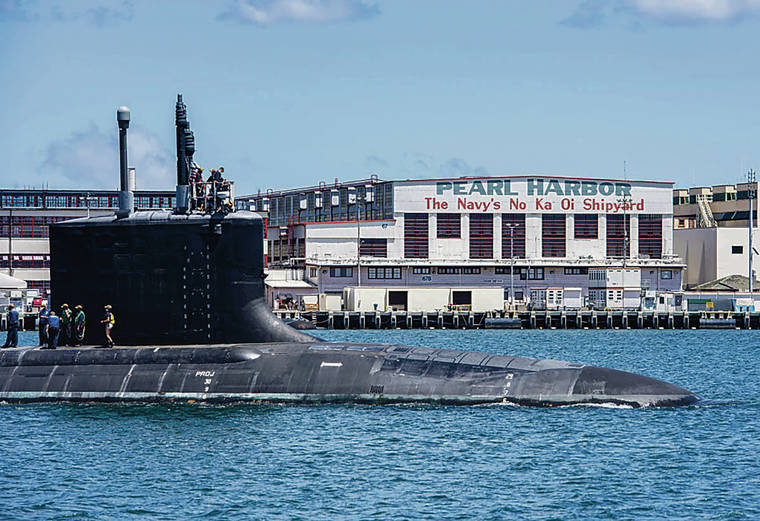As tourism stalls, military spending continues to boost Hawaii’s economy

U.S. NAVY PHOTO
The Virginia-class fast-attack submarine USS Missouri departed on May 10 after undergoing modernization work at Pearl Harbor Naval Shipyard.
One of the remaining pillars of Hawaii’s economy — federal spending, including military — continues to prop up the tourist-depleted Aloha State, with the Defense Department so far resistant to the devastating financial effects of the Opens in a new tabcoronavirus Opens in a new tab, which have resulted in a jobless rate of 22%.
One prime example: The 5,800 civilian workers at Pearl Harbor Naval Shipyard, the state’s largest industrial employer, continue work unabated, receive steady and sizable paychecks, and spend a good portion of them in the local economy.
The forward-based Pacific workforce is critical to ensuring the security of the nation, according to the shipyard, which adds about $1 billion to the state economy.
The shipyard recently completed modernization work on the Virginia-class submarine USS Missouri five days early, while a similar sub, USS Mississippi, docked May 19 for extended maintenance work expected to take two years.
Federal workers and military members statewide keep getting paid and contracts continue to be let. The University of Hawaii was just awarded a four-year contract valued at up to $75 million to continue operating the Maui High Performance Computing Center.
According to the state, Hawaii has about 42,000 active duty military personnel, nearly 10,000 Guard and Reserve members, 20,000 civilian defense workers, 60,000 dependents, 18,000 retirees and 111,000 veterans.
Don't miss out on what's happening!
Stay in touch with breaking news, as it happens, conveniently in your email inbox. It's FREE!
The U.S. Office of Personnel Management said Hawaii had 5,300 non-defense federal employees as of late 2017.
Hawaii has received more than $7 billion in federal assistance for COVID-19 response. Prior to the current emergency, for fiscal 2018, Hawaii received the second-highest infusion of defense spending in the nation as a percentage of state gross domestic product at 7.7%, according to the Office of Economic Adjustment. Only Virginia was higher at 10.3%.
“Federal spending, more than just military, is a stabilizing force now,” said Carl Bonham, executive director of the Economic Research Organization at the University of Hawaii.
“The resilience of federal government expenditure and employment in Hawaii during this pandemic sustained (nearly) 11% of GDP,” added Paul Brewbaker with TZ Economics.
Jason Chung, vice president with the military affairs council of the Chamber of Commerce Hawaii, said the state continues to play a critical and strategic role in ensuring national security and stability in the Indo-Pacific region, and “a clear benefit” of that priority is the significant impact it has on the local economy.
“We are fortunate that as” a key economic driver and one of the largest employers — 102,036 — in Hawaii, “our military bases continue to operate and function, providing economic opportunity for the state,” Chung said.
Contracting has slowed due to the Pentagon’s focus on the fight against COVID-19, but those contracts continue, nevertheless, he said.
On April 15, Hensel Phelps Construction in Honolulu was awarded a $54 million contract for the design and construction of an “undersea operational training facility” for Navy SEALs at Pearl City Peninsula.
Chung noted that the Army is proposing a $1 billion infusion over the next 10 years to upgrade infrastructure in Hawaii. Competition with China is driving continuing emphasis on Hawaii and the Pacific.
State chief economist Eugene Tian said tourism contributed $15.8 billion to Hawaii GDP, or 16.2%, based on estimates by the state Department of Business, Economic Development and Tourism for 2019. Federal spending contributed $10.4 billion to Hawaii GDP, or 10.6%.
The federal spending counted toward GDP includes payroll and contracts, Tian noted. Federal payments on retirement, Social Security and grants are not counted in GDP since they are considered “transfer payments.”
Visitor spending overtook defense spending in Hawaii in 1976, Tian said. Based on GDP, real estate is the No. 1 industry in Hawaii, tourism is No. 2, and the federal government is No. 3.
The Hawaii Tourism Authority noted visitor spending of $17.75 billion in 2019. Tian said adding airline and cruise line spending for supplies, that figure bumps up to $20.5 billion.
In a normal year, federal spending in Hawaii is over $20 billion a year, but that includes transfer payments such as retiree pay, and only about half the total counts toward GDP.
The Army said its direct spending in Hawaii is over $3.8 billion per year — including $2.6 billion for salaries of soldiers, civilian employees, reservists and retirees.
After analysis to minimize risk during the COVID-19 crisis, “the Army has continued contracted on-base construction for new and major renovations with over $643 million of ongoing awarded projects, working with the Army Corps of Engineers and providing employment for local community members,” said Dennis Drake, a spokesman for U.S. Army Garrison Hawaii.
Additional work is occurring at Schofield Barracks, including building renovations, road paving, roofing and other projects that don’t require access to occupied facilities, he said. Protection for local contractors and the community “is woven into all planning and execution of these projects,” he said.
How Hawaii will fare in future defense budgets remains to be seen. Massive debt due to the coronavirus is expected to exert pressure on future defense budgets, with no real growth expected in fiscal 2021.
Decreases in federal spending in Hawaii in an era of “great power” competition with China could have profound impacts on the state and “put Hawaii at risk of increased geopolitical or military agitation,” Brewbaker said.
Cumulative reductions, Brewbaker added, could mean not having an adequate hurricane warning system, not proceeding with a new submarine dry dock at Pearl Harbor or “being exposed to Chinese naval military provocation in the Hawaiian Islands if they decide to build their own island nearby,” as China is doing in a disputed area of the South China Sea.



